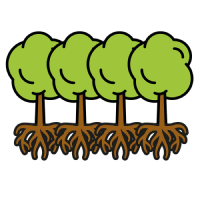When should I plant Wild Cherry hedging?
We recommend planting Wild Cherry plants in autumn, just before the first frost hits. You can plant bare root plants any time from November - March, but it is recommended that you plant at the beginning of the dormant season, if possible. This ensures the plants have enough time to settle down before being hit with freezing temperatures.
How far apart should I plant Wild Cherry plants?
You can plant Wild Cherry bare roots anything from 5 to 7 plants per metre, but this must be done in a zigzag/staggered double row. If you do not have the space for this, we recommend 3 plants per metre in a single line.
How to plant Wild Cherry:
Begin by soaking the roots for 2 hours in a bucket of water, or spraying with a garden hose, to ensure the roots are wet before planting.
Dig a hole that is twice as wide as the plant's root mass, but the same depth. If you have poor soil, mix some organic matter into the excess soil, and sprinkle some RootGrow onto the bottom of the hole (which we recommend doing, regardless of the soil type).
Once complete, place the plants into the hole, ensuring they are straight. Begin backfilling with the soil mix, patting down as you go along to remove any air bubbles. Following this, water the plants very well and place a 2-3" layer of much at the base of the plants.
You will need to continually water the plants for the first 1-2 years after planting, particularly with bare roots and throughout warmer temperatures.
Prunus Avium does require a bit of space and will not tolerate grass or weeds within 1m of its surroundings when trying to establish. It is also important to note that the plants do not tolerate drought, waterlogging soil, or extremely wet soil - though the surrounding ground must be kept moist whilst developing.














